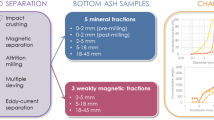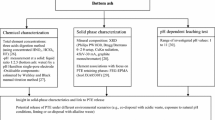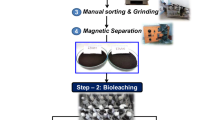Abstract
Magnetic fractions were extracted from pulverized waste-to-energy (WTE) bottom ashes using a combined wet-dry extraction method. The resulting magnetic and non-magnetic fractions were subjected to compositional, mineralogical, and redox state analyses by X-ray diffraction (XRD), X-ray fluorescence, and X-ray photoelectron spectroscopy (XPS), respectively. The distribution and leaching toxicity of heavy metals were assessed to evaluate potential effects on the environment. Compositional analyses revealed that Fe accounted for 35% of the magnetic fraction of pulverized ashes, which was approximately seven times that of the raw ash. In addition to Fe, elemental Ni, Mn, and Cr were also significantly enriched in the magnetic fractions. The mineralogical analysis determined that Fe was primarily present as hematite and magnetite, and metallic iron was also identified in the magnetic fraction samples. The XPS analysis further proved the existence of zero-valence Fe. However, a significant amount of Fe remained in the non-magnetic fractions, which could partially be ascribed to the intergrowth structure of the various minerals. The elevated concentrations of toxicity characteristic leaching procedure (TCLP)-extracted Mn, Ni, Cr, Cu, Pb, and Zn were primarily ascribed to the lower buffering capability of the magnetic fractions, with the enrichment of Mn, Ni, and Cr in the magnetic fractions also contributing to this elevation.






Similar content being viewed by others
References
Abbas Z, Moghaddam AP, Steenari BM (2003) Release of salts from municipal solid waste combustion residues. Waste Manag 23:291–305
Bae S, Lee W (2014) Influence of riboflavin on nanoscale zero-valent iron reactivity during the degradation of carbon tetrachloride. Environ Sci Technol 48:2368–2376
Bayuseno AP, Schmahl WW (2010) Understanding the chemical and mineralogical properties of the inorganic portion of MSWI bottom ash. Waste Manag 30:1509–1520
Boghetich G, Liberti L, Notarnicola M, Palma M, Petruzzelli D (2005) Chloride extraction for quality improvement of municipal solid waste incinerator ash for the concrete industry. Waste Manage Res 23:57–61
Chandler AJ, Eighmy TT, Hartlén J, Helmar O, Kosson DS, Sawel SE, van der Sloot HA, Vehlow J (1997) Municipal solid waste incinerator residues. Studies in Environmental Science, Elsevier Science, Amsterdam
Chen CH, Chiou J (2007) Distribution of chloride ion in MSWI bottom ash and de-chlorination performance. J Hazard Mater 148:346–352
De Boom A, Degrez M, Hubaux P, Lucion C (2011) MSWI boiler fly ashes: magnetic separation for material recovery. Waste Manag 31:1505–1513
Eusden JD, Eighmy TT, Hockert K, Holland E, Marsella K (1999) Petrogenesis of municipal solid waste combustion bottom ash. Appl Geochem 14:1073–1091
European Commission (EC) (2006) Integrated prevention pollution and control-reference document on the best available techniques for waste incineration http://eippcb.jrc.ec.europa.eu/reference/BREF/wi_bref_0806.pdf#. (Accessed 16.07.07)
He PJ, Song LQ, Zhang H, Shi AJ, Zhang PJ (2003) Characterization of waste incineration bottom ash and its beneficial use prospect. China Environ Sci 23:395–398 (in Chinese)
Hulett LD, Weinberger AJ, Northcutt KJ, Ferguson M (1980) Chemical species in fly ash from coal-burning power plants. Science 210:1356–1358
Jiao F, Zhang L, Dong Z, Namioka T, Yamada N, Ninomiya Y (2016) Study on the species of heavy metals in MSW incineration fly ash and their leaching behavior. Fuel Process Technol 152:108–115
Kukier U, Ishak CF, Sumner ME, Miller WP (2003) Composition and element solubility of magnetic and non-magnetic fly ash fractions. Environ Pollut 123:255–266
Le Forestier L, Libourel G (1998) Characterization of flue gas residues from municipal solid waste combustors. Environ Sci Technol 32:2250–2256
Lu SG, Chen YY, Shan HD, Bai SQ (2009) Mineralogy and heavy metal leachability of magnetic fractions separated from some Chinese coal fly ashes. J Hazard Mater 169:246–255
Long HM, Meng QM, Wang P, Chun TJ, Yao YL (2015) Preparation of chromium iron metal powder from chromium slag by reduction roasting and magnetic separation. J Iron Steel Res Int 22:771–776
Lynn CJ, Dhir RK, Ghataora GS (2016) Municipal incinerated bottom ash characteristics and potential for use as aggregate in concrete. Constr Build Mater 127:504–517
Meima JA, Comans RNJ (1997) Geochemical modeling of weathering reactions in municipal solid waste incinerator bottom ash. Environ Sci Technol 31:1269–1276
Meima JA, Comans RNJ (1999) The leaching of trace elements from municipal solid waste incinerator bottom ash at different stages of weathering. Appl Geochem 14:159–171
Menad N, Kanari N, Save M (2014) Recovery of high grade iron compounds from LD slag by enhanced magnetic separation techniques. Int J Miner Process 126:1–9
National Bureau of Statistics of China (2015) China statistical yearbook. China Statistics Press, Beijing
Nilsson M, Andreas L, Lagerkvist A (2016) Effect of accelerated carbonation and zero valent iron on metal leaching from bottom ash. Waste Manag 51:97–104
Oehmig WN, Roessler JG, Zhang J, Townsend TG (2015) Effect of ferrous metal presence on lead leaching in municipal waste incineration bottom ashes. J Hazard Mater 283:500–506
Saffarzadeh A, Shimaoka T, Wei YM, Gardner KH, Musselman CN (2011) Impacts of natural weathering on the transformation/neoformation processes in landfilled MSWI bottom ash: a geoenvironmental perspective. Waste Manag 31:2440–2454
Santos RM, Mertens G, Salman M, Cizer Ö, Van Gerven T (2013) Comparative study of ageing, heat treatment and accelerated carbonation for stabilization of municipal solid waste incineration bottom ash in view of reducing regulated heavy metal/metalloid leaching. J Environ Manag 128:807–821
Saqib N, Bäckström M (2016) Chemical association and mobility of trace elements in 13 different fuel incineration bottom ashes. Fuel 172:105–117
Su LH, Guo GZ, Shi XL, Zuo MY, Niu DJ, Zhao A, Zhao YC (2013) Copper leaching of MSWI bottom ash co-disposed with refuse: effect of short-term accelerated weathering. Waste Manag 33:1411–1417
Tessier A, Campbell PGC, Bisson M (1979) Sequential extraction procedure for the speciation of particulate trace metals. Anal Chem 51:844–851
United States Environmental Protection Agency (US EPA) (1992) SW-846 Test Method 1311: Toxicity Characteristic Leaching Procedure. https://www.epa.gov/hw-sw846/sw-846-test-method-1311-toxicity-characteristic-leaching-procedure. (Accessed 16.06.06)
Van Caneghem J, Verbinnen B, Cornelis G, de Wijs J, Mulder R, Billen P, Vandecasteele C (2016) Immobilization of antimony in waste-to-energy bottom ash by addition of calcium and iron containing additives. Waste Manag 54:162–168
Wang FH, Zhang F, Chen YJ, Gao J, Zhao B (2015) A comparative study on the heavy metal solidification/stabilization performance of four chemical solidifying agents in municipal solid waste incineration fly ash. J Hazard Mater 300:451–458
Wei YM, Shimaoka T, Saffarzadeh A, Takahashi F (2011a) Alteration of municipal solid waste incineration bottom ash focusing on the evolution of iron-rich constituents. Waste Manage 31:1992–2000
Wei YM, Shimaoka T, Saffarzadeh A, Takahashi F (2011b) Mineralogical characterization of municipal solid waste incineration bottom ash with an emphasis on heavy metal-bearing phases. J Hazard Mater 187:534–543
Wei YM, Saffarzadeh A, Shimaoka T, Zhao C, Peng XY (2014) Geoenvironmental weathering/deterioration of landfilled MSWI-BA glass. J Hazard Mater 278:610–619
White WM (2013) Geochemistry, John Wiley & Sons, Ltd., first ed., New Jersey
Xia Y, He PJ, Shao LM, Zhang H (2017) Metal distribution characteristic of MSWI bottom ash in view of metal recovery. J Environ Sci 52:178–189
Yang R, Liao WP, Wu PH (2012) Basic characteristics of leachate produced by various washing processes for MSWI ashes in Taiwan. J Environ Manag 104:67–76
Yang S, Saffarzadeh A, Shimaoka T, Kawano T (2014) Existence of Cl in municipal solid waste incineration bottom ash and dechlorination effect of thermal treatment. J Hazard Mater 267:214–220
Yao J, Li WB, Kong QN, Wu YY, He R, Shen DS (2010) Content, mobility and transfer behavior of heavy metals in MSWI bottom ash in Zhejiang province, China. Fuel 89:616–622
Yao QJ, Samad NB, Keller B, Seah XS, Huang L, Lau R (2014) Mobility of heavy metals and rare earth elements in incineration bottom ash through particle size reduction. Chem Eng Sci 118:214–220
Zhu XM, Zhang YS (1998) An XPS study of passive film formation on Fe 30Mn 9Al alloy in sodium sulphate solution. Appl Surf Sci 125:11–16
Acknowledgements
This work was supported by the National Natural Science Foundation of China (Grant No. 51308564) and National Science Foundation Project of CQ CSTC (Grant No. CSTC2014jcyjA20015).
Author information
Authors and Affiliations
Corresponding author
Additional information
Responsible editor: Bingcai Pan
Rights and permissions
About this article
Cite this article
Wei, Y., Mei, X., Shi, D. et al. Separation and characterization of magnetic fractions from waste-to-energy bottom ash with an emphasis on the leachability of heavy metals. Environ Sci Pollut Res 24, 14970–14979 (2017). https://doi.org/10.1007/s11356-017-9145-8
Received:
Accepted:
Published:
Issue Date:
DOI: https://doi.org/10.1007/s11356-017-9145-8




